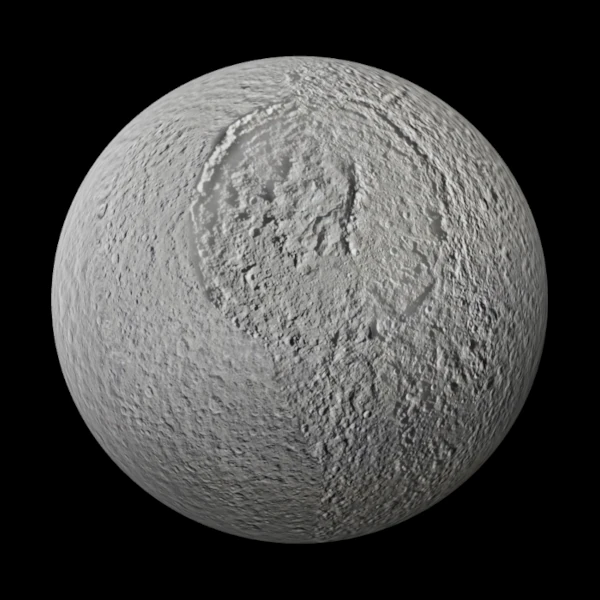
Tethys is one of Saturn's large icy moons, discovered in 1684 by Giovanni Domenico Cassini (1625-1712). With an average radius \(R = 531\ \mathrm{km}\) and a density \(\rho = 0.984\ \mathrm{g.cm^{-3}}\), Tethys is mainly composed of solid water ice, with a small fraction of silicate rock. Its very bright surface (albedo above 0.8) makes it one of the most reflective objects in the Solar System.
Images from the Cassini spacecraft (1997-2017) revealed a nearly frozen relief: ancient craters, icy plains, and a huge fracture called Ithaca Chasma, over 2000 km long, crossing nearly three-quarters of the moon's circumference. Ithaca Chasma reflects an ancient expansion of Tethys' crust, probably linked to the solidification of an internal ocean, whose volume increase caused surface fractures.
Tethys' rotation is synchronous: it always shows the same face to Saturn, like the Moon with respect to Earth. Its nearly circular orbit at an average distance of \(294,660\ \mathrm{km}\) from the planet suggests gravitational stabilization by orbital resonance with neighboring moons Mimas and Enceladus. This resonance produces weak tidal stresses, maintaining a balance between complete solidification and slight plasticity of the ice mantle.
Infrared spectra indicate that Tethys' surface is almost entirely crystalline water ice, with some traces of ammonia and dark organic compounds deposited by micrometeorites. Tethys' low density combined with its moderate radius produces a surface gravity of about \(0.15\ \mathrm{m.s^{-2}}\), less than 2% of Earth's gravity. With such low gravity, material ejected by impacts falls slowly, preserving ancient craters.
| Moon | Average distance from Saturn (km) | Radius (km) | Density (g/cm³) | Average temperature (K) | Feature |
|---|---|---|---|---|---|
| Mimas | 185,520 | 198 | 1.15 | 64 | Herschel crater, pronounced relief |
| Enceladus | 237,950 | 252 | 1.61 | 75 | Active cryovolcanic plumes |
| Tethys | 294,660 | 531 | 0.984 | 86 | Ithaca Chasma, very bright surface |
| Dione | 377,400 | 561 | 1.48 | 84 | Old craters and linear fractures |
| Rhea | 527,040 | 764 | 1.23 | 99 | Craters, possible faint ring |
| Iapetus | 3,560,820 | 734 | 1.03 | 110 | Two-tone surface, synchronous rotation |
Sources: ESA – Cassini-Huygens Mission.
Without an atmosphere, Tethys experiences neither wind nor erosion. Each impact remains visible for billions of years, preserved in the extreme cold. In this environment, surface temperatures range from 70 K to 90 K depending on solar exposure, around \(-200\ ^\circ\mathrm{C}\). This silent world illustrates the thermal and mechanical stability of an isolated icy body over 4.5 billion years, keeping intact the memory of the early Solar System.